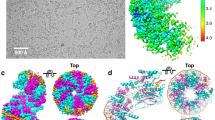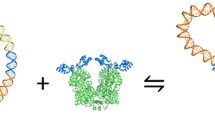Abstract
Quantitative analysis was performed for the first time for the interaction of Escherichia coli RecA, which plays the central role in homologous recombination, and ssDNA varying in length and structure. DNA recognition was shown to depend on weak additive interactions between RecA monomers of the filament and various structural elements of DNA. Orthophosphate and dNMPs acted as minimal inhibitors of RecA filamentation on d(pN)20. A stepwise increase in homooligonucleotide length by one nucleotide (from 2 to 20 nt) monotonically increased the affinity approximately twofold (factor f) due to weak additive contacts of RecA with each internucleoside phosphate (f ≈ 1.56) and specific interactions with T and C (f ≈ 1.32). In the case of d(pA) n , the RecA filament showed virtually no interaction with bases and interacted more efficiently with internucleoside phosphates of the first than of the next helix turn (n < 10, f ≈ 2.1 vs. n > 10, f ≈ 1.3). The affinity of RecA for d(pN) n and various modified bases proved to depend on the base, the DNA structure, and the conformation of the sugar-phosphate backbone. The affinity considerably increased with bases containing exocyclic proton-accepting groups. Possible causes of the preferential binding of RecA with DNAs of a particular length and composition are considered. Mechanisms are proposed for ssDNA recognition by RecA and for homologous strand exchange.
Similar content being viewed by others
REFERENCES
Lusetti S.L., Cox M.M. 2002. The bacterial RecA protein and the recombinational DNA repair of stalled replication forks. Annu. Rev. Biochem. 71, 71–100.
Amaratunga M., Benight A.S. 1988. DNA sequence dependence of ATP hydrolysis by RecA protein. Biochem. Biophys. Res. Commun. 157, 127–133.
Cazenave C., Chabbert M, Toulme J.J., Helene C. 1984. Absorption and fluorescence studies of the binding of the recA gene product from E. coli to single-stranded and double-stranded DNA. Ionic strength dependence. Biochim. Biophys. Acta. 781, 7–13.
McEntee K., Weinstock G.M., Lehman I.R. 1981. Binding of the RecA protein of Escherichia coli to single-and double-stranded DNA. J. Biol. Chem. 256, 8835–8844.
Tracy R.B., Kowalczykowski S.C. 1996. In vitro selection of preferred DNA pairing sequences by the Escherichia coli RecA protein. Genes Dev. 10, 1890–1903.
Yu X., Egelman E.H. 1992. Structural data suggest that the active and inactive forms of the RecA filament are not simply interconvertible. J. Mol. Biol. 227, 334–346.
Register J.C., 3rd, Griffith J. 1985. The direction of RecA protein assembly onto single strand DNA is the same as the direction of strand assimilation during strand exchange. J. Biol. Chem. 260, 12308–12312.
Bork J.M., Cox M.M., Inman R.B. 2001. RecA protein filaments disassemble in the 5′ to 3′ direction on single-stranded DNA. J. Biol. Chem. 276, 45740–45743.
Stasiak A., Di Capua E. 1982. The helicity of DNA in complexes with RecA protein. Nature. 299, 185–186.
Pugh B.F., Schutte B.C., Cox M.M. 1989. Extent of duplex DNA underwinding induced by RecA protein binding in the presence of ATP. J. Mol. Biol. 205, 487–492.
Heuser J., Griffith J. 1989. Visualization of RecA protein and its complexes with DNA by quick-freeze/deep-etch electron microscopy. J. Mol. Biol. 210, 473–484.
Mazin A.V., Kowalczykowski S.C. 1998. The function of the secondary DNA-binding site of RecA protein during DNA strand exchange. EMBO J. 17, 1161–1168.
Zhurkin V.B., Raghunathan G., Ulyanov N.B., Camerini-Otero R.D., Jernigan R.L. 1994. A parallel DNA triplex as a model for the intermediate in homologous recombination. J. Mol. Biol. 239, 181–200.
Kim M.G., Zhurkin V.B., Jernigan R.L., Camerini-Otero R.D. 1995. Probing the structure of a putative intermediate in homologous recombination: The third strand in the parallel DNA triplex is in contact with the major groove of the duplex. J. Mol. Biol. 247, 874–889.
Zhou X., Adzuma K. 1997. DNA strand exchange mediated by the Escherichia coli RecA protein initiates in the minor groove of double-stranded DNA. Biochemistry. 36, 4650–4661.
Howard-Flanders P., West S.C., Stasiak A. 1984. Role of RecA protein spiral filaments in genetic recombination. Nature. 309, 215–219.
Roca A.I., Cox M.M. 1997. RecA protein: Structure, function, and role in recombinational DNA repair. Prog. Nucleic Acids Res. Mol. Biol. 56, 129–223.
Folta-Stogniew E., O'Malley S., Gupta R., Anderson K.S., Radding C.M. 2004. Exchange of DNA base pairs that coincides with recognition of homology promoted by E. coli RecA protein. Mol. Cell. 15, 965–975.
Malkov V.A., Camerini-Otero R.D. 1995. Photo-crosslinks between single-stranded DNA and Escherichia coli RecA protein map to loops L1 (amino acid residues 157–164) and L2 (amino acid residues 195–209). J. Biol. Chem. 270, 30230–30233.
Morimatsu K., Horii T., Takahashi M. 1995. Interaction of Tyr103 and Tyr264 of the RecA protein with DNA and nucleotide cofactors. Fluorescence study of engineered proteins. Eur. J. Biochem. 228, 779–785.
Morimatsu K., Horii T. 1995. Analysis of the DNA binding site of Escherichia coli RecA protein. Adv. Biophys. 31, 23–48.
Morimatsu K., Funakoshi T., Horii T., Takahashi M. 2001. Interaction of tyrosine 65 of RecA protein with the first and second DNA strands. J. Mol. Biol. 306, 189–199.
Rehrauer W.M., Kowalczykowski S.C. 1996. The DNA binding site(s) of the Escherichia coli RecA protein. J. Biol. Chem. 271, 11996–12002.
Bugreev D.V., Nevinsky G.A. 1999. Potential of the method of stepwise increase in ligand complexity in studies of protein-nucleic acid interactions: Mechanisms of the functioning of some replication, repair, topoisomerization, and restriction enzymes. Biokhimiya. 64, 237–249.
Nevinsky G.A. 2004. The role of weak specific and nonspecific interactions in enzymatic recognition and conversion of long DNAs. Mol. Biol. 38, 636–662.
Nevinsky G.A. 2003. Structural, thermodynamic, and kinetic basis of DNA-and RNA-dependent enzymes functioning. Important role of weak nonspecific additive interactions between enzymes and long nucleic acids for their recognition and transformation. In: Protein Structures. Kaleidoscope of Structural Properties and Functions. Ed. Uversky V.N. Fort P.O.: Research Signpost, 133–222.
Nevinsky G.A. 1995. The essential role of weak interactions in enzyme recognition of long DNA and RNA molecules. Mol. Biol. 29, 16–37.
Vinogradova N.L., Bulychev N.V., Maksakova G.A., Johnson F., Nevinsky G.A. 1998. Uracil-DNA glycosylase: Interpretation of X-ray data in the light of kinetic and thermodynamic studies. Mol. Biol. 32, 498–508.
Ishchenko A.A., Vasilenko N.L., Sinitsina O.I., Yamkovoi V.I., Fedorova O.S., Douglas K.T., Nevinsky G.A. 2002. Thermodynamic, kinetic, and structural basis for recognition and repair of 8-oxoguanine in DNA by Fpg protein from Escherichia coli. Biochemistry. 41, 7540–7548.
Fedorova O.S., Nevinsky G.A., Koval V.V., Ishchenko A.A., Vasilenko N.L., Douglas K.T. 2002. Stopped-flow kinetic studies of the interaction between Escherichia coli Fpg protein and DNA substrates. Biochemistry. 41, 1520–1528.
Beloglazova N.G., Kirpota O.O., Starostin K.V., Ishchenko A.A., Yamkovoy V.I., Zharkov D.O., Douglas K.T., Nevinsky G.A. 2004. Thermodynamic, kinetic and structural basis for recognition and repair of abasic sites in DNA by apurinic/apyrimidinic endonuclease from human placenta. Nucleic Acids Res. 32, 5134–5146.
Kolocheva T.I., Maksakova G.A., Bugreev D.V., Nevinsky G.A. 2001. Interaction of endonuclease EcoRI with short specific and nonspecific oligonucleotides. IUBMB Life. 51, 189–195.
Bugreev D.V., Baranova S., Zakharova O.D., Parissi V., Desjobert C., Sottofattori E., Balbi A., Litvak S., Tarrago-Litvak L., Nevinsky G.A. 2003. Dynamic, thermodynamic, and kinetic basis for recognition and transformation of DNA by human immunodeficiency virus type 1 integrase. Biochemistry. 42, 9235–9247.
Bugreev D.V., Sinitsina O.I., Buneva V.N., Nevinsky G.A. 2003. Mechanism of supercoiled DNA recognition by eukaryotic topoisomerases I: 1. Interaction of enzymes with nonspecific oligonucleotides. Bioorg. Khim. 29, 163–174.
Bugreev D.V., Buneva V.N., Sinitsina O.I., Nevinsky G.A. 2003. Mechanism of supercoiled DNA recognition by eukaryotic topoisomerases I: 2. Comparison of enzyme interactions with specific and nonspecific oligonucleotides. Bioorg. Khim. 29, 275–288.
Schuster H. 1960. The method of reaction of deoxyribonucleic acid with nitrous acid. Z. Naturforsch. 15B, 298–304.
Vielmetter W., Schuster H. 1960. Base specificity in the induction of mutations by nitrous acid in phage T-2. Z. Naturforsch. 15B, 304–311.
Ishchenko A.A., Bulychev N.V., Zharkov D.O., Maksakova G.A., Johnson F., Nevinsky G.A. 1997. Isolation of 8-oxoguanine DNA glycosylase from E. coli and analysis of its substrate specificity. Mol. Biol. 31, 332–337
Handbook of Biochemistry and Molecular Biology: Nucleic Acids. Ed. Fasman G.D. Boca Raton, Florida: CRC Press, 1975.
Cox M.M., McEntee K., Lehman I.R. 1981. A simple and rapid procedure for the large scale purification of the RecA protein of Escherichia coli. J. Biol. Chem. 256, 4676–467.
Bianco P.R., Weinstock G.M. 1996. Interaction of the RecA protein of Escherichia coli with single-stranded oligodeoxyribonucleotides. Nucleic Acids Res. 24, 4933–4939.
Leahy M.C., Radding C.M. 1986. Topography of the interaction of RecA protein with single-stranded deoxyoligonucleotides. J. Biol. Chem. 261, 6954–6960.
Fersht A. 1984. Enzyme Structure and Mechanism. N.Y.: W.H. Freeman.
Saenger W. 1984. Principles of Nucleic Acid Structure. N.Y.: Springer.
Author information
Authors and Affiliations
Additional information
__________
Translated from Molekulyarnaya Biologiya, Vol. 39, No. 6, 2005, pp. 984–998.
Original Russian Text Copyright © 2005 by Bugreeva, Bugreev, Nevinsky.
Rights and permissions
About this article
Cite this article
Bugreeva, I.P., Bugreev, D.V. & Nevinsky, G.A. Physicochemical Basis of RecA Filamentation on Single-Stranded DNA. Mol Biol 39, 862–875 (2005). https://doi.org/10.1007/s11008-005-0107-8
Received:
Issue Date:
DOI: https://doi.org/10.1007/s11008-005-0107-8




